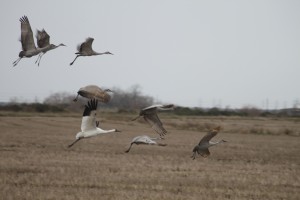by Renée Francoeur
Wood Buffalo National Park’s flock of whooping cranes is headed home to the Northwest Territories.
The Whooping Crane Conservation Association (WCCA)reported last week that approximately 50 to 60 per cent of the cranes had already left their wintering grounds on the Texas coast in the Aransas National Wildlife Refuge.
On Thursday, WCCA’s Chester McConnell said he received word of the first whooping crane sighting of the year in Canada from an observer in Radisson, Sask.
“The citizen who reported (it) advised that one and one-half foot of snow was on the ground, but the whoopers were standing in a dugout,” McConnell said in an email. “Hopefully the Canadian public will be happy that their birds are coming home to nest.”
The birds undertake the 2,500 mile migration each year to nest and rear their young in Wood Buffalo.
US Whooping Crane Recovery Coordinator Wade Harrell monitors the flock in Aransas and reported to McConnell that despite some cranes still being observed on the refuge, the migration is well underway.
While the birds seem to be leaving en masse, they actually have staggered departures and leave in small groups, Harrell related.
Bird watchers can log their crane sightings at https://whoopingcrane.com/report-a-sighting/ .
To see a map illustrating the cranes’ 2013 migratory progress, visit https://whoopingcrane.com/migration/ where observations have been posted since mid March. This map cannot be used to locate the birds as all postings are delayed by at least one week to help prevent harassment of the birds.
Canada is home to the world’s largest migratory population of whooping cranes. According to Environment Canada, there are almost 300 birds in the migratory Wood Buffalo flock.
Whooping cranes were designated as endangered in Canada in the year 2000. The birds are protected by the Migratory Bird Treaty Act and the Endangered Species Act.



